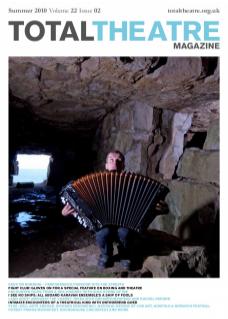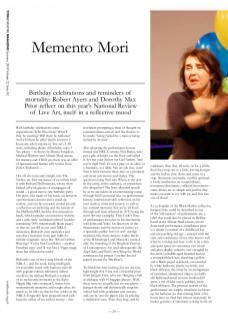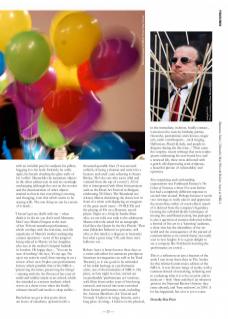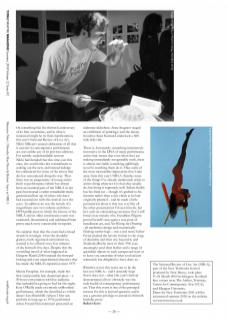With birthday celebrations come expectations: Who’ll be there? What’ll they be wearing? Will there be balloons? And will there be jelly? Quick answers: 1 Everyone who’s anyone in ‘live art’; 2 All sorts, including plenty of birthday suits; 3 Yes, plenty – in shows by Marcia Farquhar, Michael Mayhew and Alistair MacLennan, for starters; and 4 Well yes, there was an offer of liposuctioned human jelly terrine from Zoran Todorovic…
Hot off the train and straight into The Arches, my first encounter of an artistic kind is with Richard DeDomenici, whose show kicked off with glasses of champagne all round – a good start to any birthday party. His piece, like much of his work, sat between a performance-lecture and a stand-up routine, and on this occasion circled around a reflection on archiving and the launch of the DeDomeNRLArchive documentation bank, which includes an interactive website and a nifty little ‘unlimited edition’ booklet containing ‘50% intentionally blank pages’ so that we can fill in our own NRLA memories. Richard’s own memories and noted key moments from past NRLAs include enigmatic notes like ‘What’s Gillian Wearing?’ ‘Cunty Nut Cornflakes – another Freudian typo’ and ‘It was like a Vegas magic show but without the tricks’.
Richard is one of the young bloods of the NRLA – and his work, being intelligent yet accessible, laced with humour and rife with popular culture references (where would we be without Richard to remind of us such iconic moments as the Kylie Nipple Slip video moment?), makes him tremendously attractive and sought after. So much so, he tells us, that he has, whilst at the NRLA, frequently been propositioned with lucrative offers of sex and/or money – this revelation prompting a train of thought on commercialism and art and the choices to be made: ‘being fucked by a man or being fucked by the man’.
Also adopting the performance-lecture format was NRLA veteran Neil Butler, who put a pile of bricks on the floor and called it Art (eat your (he)art out Carl Andre). And you’re right Neil, it’s not a pipe, or an altar, or a fountain, or a table. Not an oak tree, even! Neil is better known these days as a producer and street arts mover and shaker. The question taxing Neil was: Where is the art? In the artist, in the audience, or somewhere else altogether? The hour allocated speeds by as we are taken on an entertaining romp through Neil’s personal take on performance history, interweaved with reflection on his own work as artist and curator, as well as key cultural moments that we’ve all lived through and been affected by (9/11 being the most obvious example). This Cook’s Tour of performance art takes in his fascination with John and Yoko; his discovery of the Situationists and the notion of society as a spectacle; public ‘but is it art?’ outrage moments like those famous Andre bricks at the Whitechapel, and Manzini’s canned shit; the founding of the Brighton Festival of Contemporary Art (and subsequently the Zap Club); and Neil’s own Wrap the World continuous fax project (‘a white line [of paper] around the Meridian’).
To finish the first evening (for me anyway, lightweight that I am) was a beautiful piece from Juergen Fritz, who was ‘Ringing a bell in dialogue with 10 bagpipe players’. Well, there were six actually, but six was plenty – Juergen slowly and rhythmically rings his school bell with pendulum arm sweeps, and one by one the pipers join in, playing a traditional tune. Then they stop, and he continues, then they all carry on for a while, then they stop one at a time, leaving Juergen and the bell to slow down and come to a stop. Shamanic, mesmeric, soulful, spiritual: a lovely meditation on sound/silence, resonance/dissonance, stillness/movement – some shows are so simple and perfect they make you want to cry with joy and this was one of those!
As co-founder of the Black Market collective, Juergen Fritz could be described as one of the ‘old masters’ of performance art, a label that could also be placed on Belfastbased artist Alistair MacLennan, whose durational performance–installation piece is a tender evocation of a childhood lost and encroaching old age – enacted with the style and confidence of one who knows well what he is doing and how to do it. In a dim and quiet space we encounter two woodand-glass display cabinets, one occupied by the artist (a middle-aged bearded man in a crumpled black suit, clutching a pillow and a blank-paged notebook, surrounded by white balloons, plastic toy birds, and black ribbons); the other by an arrangement of tarnished, abandoned objects (a child’s old-fashioned metal scooter, broken doll parts, a set of false teeth, pebbles, more black ribbons). The physical actions of the performance are simple, ritualistic: he blows up the balloons (so that coming back a few hours later we find him almost obscured); he makes gestures of automatic writing in the air with an invisible pen; he readjusts his pillow, hugging it to his body forlornly; he softly sighs, his breath clouding the glass walls of his ‘coffin’. Meanwhile the inanimate objects in the other cabinet just sit and sit, seemingly unchanging (although the rust on the scooter and the discolouration of other objects remind us that in fact everything is moving and changing, even that which seems to be staying still). The one thing we can be certain of is death…
‘I haven’t got my skulls with me – when death is in the air you don’t need Memento Mori’ says Marcia Farquar at the start of her 30-hour marathon performance, which overlaps with the real-time, real-life experience of Marcia’s mother undergoing a major operation – news of her progress being relayed to Marcia via her daughter, who was at the mother’s hospital bedside in London. Oh happy days… ‘You can be sure of nothing’ she says, ‘it’s my age, I’m up to my waist in sand’, then starting in on a review of her own 30-plus year performance history which parallels that of the NRLA – ‘preserving the times, preserving the things’ – starting with the Art Povera of her coat-ofmink-and-teddies (made at art school, which she attended as a mature student), which serves as a duvet cover when she finally exhausts herself and needs to sleep awhile…
But before we get to that point, there are hours of anecdotes, spattered with a thousand quotable lines (‘I was accused unfairly of being a shaman and went into a lavatory and cried’, and, referring to Stuart Brisley, ‘He’s the one who sat in offal and vomited from the top of a tower’). All of this is interspersed with films from projects such as the Dead Art Festival in Margate, celebrating TS Eliot’s The Wasteland (we witness Marcia declaiming the classic text in front of a white wall displaying an anagram of the great man’s name – TOILETS) and the playing of 45s on a Dansette record player: Puppet on a String by Sandie Shaw who, we are told, was rude to the adolescent Marcia when she asked for an autograph; God Save the Queen by the Sex Pistols: ‘That man [Malcolm Mclaren we presume, still alive at this time!] is a disgrace to humanity but what a great song.’ Oh, and there were balloons too…
Robert Ayers is better known these days as a writer and editor for numerous prestigious American art magazines (as well as for Total Theatre!), so it was good to be reminded of his noble heritage as a performance artist, one of the luminaries of NRLA. His piece, set late night in a bar, started out on predictable ‘performance art’ territory, with films from earlier years of him being tattooed, and moved into texts reworked from former performance work, including the Arizona Manifesto (for Visceral and Virtual): ‘I believe in twigs, biscuits, and a long piece of string... I believe in the physical, in the immediate, in direct, bodily contact... I am moved to tears by birthday parties, fireworks, pantomimes and circuses, magic acts, radio ventriloquists... carol singing, Halloween, Punch & Judy, and people in disguise during the day time...’. Then came the surprise: recent writings that were tender poems celebrating his new-found love and a renewed life, these texts delivered with a gently self-deprecating semi-striptease, a beautiful picture of vulnerability and openness.
Also surprising and confounding expectations was Forkbeard Fantasy’s The Colour of Nonsense, a show I’ve seen before but had a completely different response to second time around. Perhaps because it needs two viewings to really take in and appreciate the marvellous mêlée of visual effects (much of it derived from the company’s legendary ‘crossing the celluloid divide’ techniques of mixing live and filmed action), but perhaps it is also a question of context: delivered within a festival of live art to a ‘knowing’ audience, a show that has the absurdities of the art world and the consequences of the pursuit of commercialism as its central theme can really soar to new heights. It is a great delight to see a company like Forkbeard storming the performance art crowd…
This is a reflection on just a fraction of the work I saw in my three days in The Arches for this thirtieth anniversary edition of the NRLA. A very diverse range of works, with a common thread of reworking, reflecting and re-evaluating what it is to be an artist and to make art – both ‘there and then’ (at whatever point in the National Review’s history they came aboard), and ‘here and now’, in 2010. A lot has happened, but a lot is yet to come.
Dorothy Max Prior
On something like the thirtieth anniversary of its first occurrence, and in what is rumoured might be its final manifestation, this year’s National Review of Live Art, Nikki Milican’s annual celebration of all that is current in contemporary performance art, was unlike any of its previous editions. For entirely understandable reasons Nikki had decided that this time, just this once, she would relax her commitment to seeking out the new, and instead indulge her enthusiasm for some of the artists that she has encountered along the way. Thus there was no programme of young artists fresh to performance (which has always been an essential part of the NRLA in the past) but instead a rather remarkable multi-generational line-up of artists who have had associations with this festival over the years. In addition we saw the launch of a magnificent new two-volume-and-three-DVD publication in which the history of the NRLA and its older constituent events was examined, documented, and celebrated from pretty much every conceivable viewpoint.
No surprise then that the event had a broad strand of nostalgia. Over-the-shoulder glances, both organised and instinctive, seemed to be offered every few minutes of the festival’s five days. Despite this the overriding mood of what happened in Glasgow March 2010 retained the forward-looking and even experimental character that has made the NRLA’s reputation since 1979.
Marcia Farquhar, for example, made her first (and possibly last) durational piece – a 30-hour conversation with her audience that included her going to bed for the night; Kira O’Reilly made an entirely unbloodied performance, which she described as ‘a little dance’; Ian Hinchliffe (whom I first saw perform as long ago as 1974) performed sober; Forced Entertainment presented an elaborate slideshow; Anne Seagrave staged an exhibition of paintings; and the always inventive Kate Stannard undertook a 860- mile bike ride.
There is, fortunately, something instinctively innovative in the DNA of many performance artists that means that even when they are making immediately recognisable work, there is almost inevitably something upliftingly novel in watching them do it. Thus some of the most memorable impressions that I take away from this year’s NRLA (besides some of the things I’ve already mentioned) relate to artists doing whatever it is that they usually do, but doing it supremely well. Stelarc finally has his third ear – though it’s grafted to his forearm rather than to his cheek as he had originally planned – and he made a little presentation about it that was very like all the other presentations I’d seen him do, but he’s such an entertaining raconteur that I still loved every minute of it; Geraldine Pilgrim proved herself once again a true poet of installation art, and Not Waving but Drowning – all modernist design and eccentrically floating carrier bags – was a real treat; Esther Ferrer pushed the lecture format to the verge of absurdity and then way beyond it; and Akademia Ruchu (now in their 37th year, amazingly) used their bodies and a range of quotidian objects in such unexpected ways as to leave you uncertain of what you had just witnessed, but delighted to have done so.
Whether or not this turns out to be the last ever NRLA – and I sincerely hope that it does not – what this year’s festival demonstrated all too obviously was the rude health of contemporary performance art. That this event is one of the principal reasons for this is beyond question, and it was a genuine privilege to attend its thirtieth birthday party.
Robert Ayers
The National Review of Live Art (NRLA), part of the New Territories festival produced by New Moves, took place 17–21 March 2010 in Glasgow, Scotland. Key venues were The Arches, Tramway, Centre for Contemporary Arts (CCA), and Glasgow University.
Dates for New Territories 2011 will be announced summer 2010 on the website. www.newmoves.co.uk



